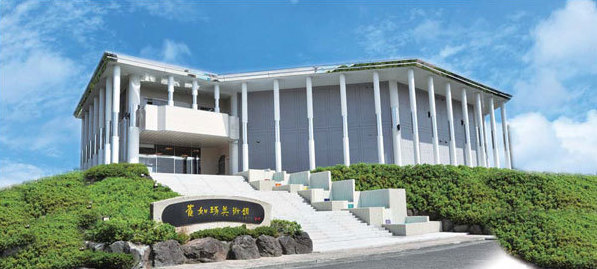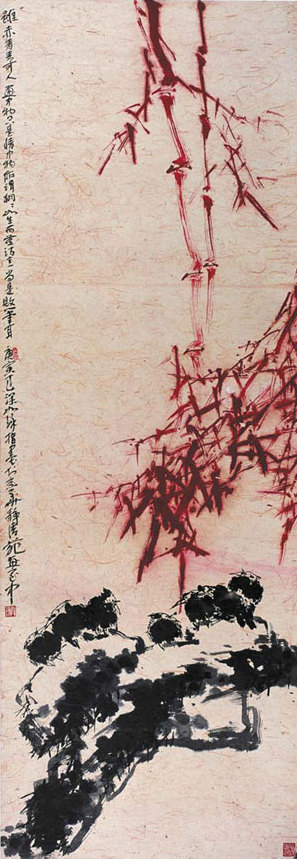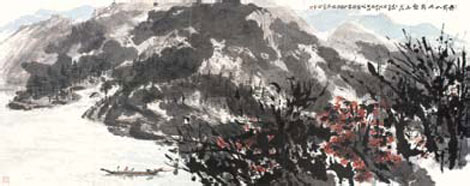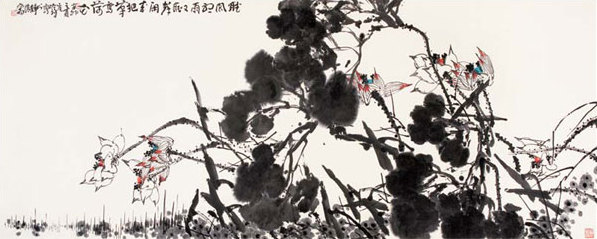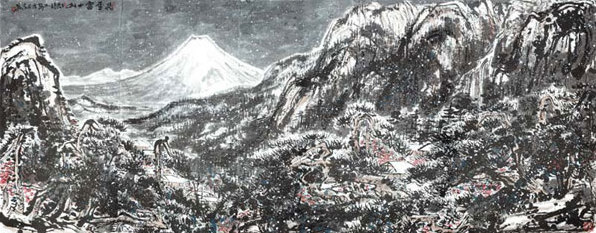Local art, global vision
Updated: 2013-09-15 07:32
By Zhuan Ti (China Daily)
|
|||||||||||
Though Cui Ruzhuo has achieved more than most, the renowned painter has even bigger ambitions to realize, Zhuan Ti reports
For an artist, Cui Ruzhuo may have accomplished everything he could have possibly imagined - global renown as well as a personal gallery. But Cui has a much bigger dream to realize.
"I hope that through my work in the art field, Chinese art can radiate to the West, and the artwork can work as a medium to allow the world know more about Chinese culture," Cui said.
Born in Beijing in 1944, Cui fell in love with watercolor painting and Chinese calligraphy at a young age. He settled in the United States in 1981. In 1996, he returned to China and taught at the Central Academy of Fine Arts. Currently, he is a professor at the China National Academy of Art.
|
Scenery of the southern bank of the Yangtze River (2012, 36cm*285.5cm) |
|
The Cui Ruzhuo Art Gallery in Japan |
|
Red Bamboo (2010, 211cm*72cm) |
|
Frost and forest (2011, 143cm*365cm) |
|
Lotus listening to rain, wind and sounds (2011, 150cm*374cm) |
|
Flying snow on Mount Fuji (2012, 143.5cm*364cm) |
Cui recently moved one step further toward his dream. On Sept 7, an opening ceremony was held in Beijing for the Cui Ruzhuo Art Gallery in Japan, which also marked the start of the Japan tour of Cui's artwork.
At the ceremony, Cui elaborated on what he hopes to accomplish with the tour.
He said that China and Japan have already built close economic ties, but people usually neglect the need to form deep cultural bonds.
"Painting and calligraphy are both treasures of Chinese culture and can also be a bridge of cultural exchange," he said.
For thousands of years, the cultures of China and Japan have influenced one another. Cultural exchanges will continue to form an important bond between the two countries in the future, he added.
Unlike many traditional watercolor painters, he has traveled around the world, and his artwork combines the natural stroke of Chinese brushwork with Western aesthetics, making them equally appealing to lovers of fine art in the East and the West.
Rao Zongyi, a master of Chinese traditional culture, described Cui as a "leader in the painting field".
Japanese representatives attending the opening ceremony of Cui's gallery also spoke highly of his artistic achievements and cultural contributions.
The ABP London Chief Representative in China Liu Tongbo praised Cui's art as well, adding that his work shows the market trend and has gained influence in Asia and throughout the world.
As Cui's influence continues to increase in the near future, maybe his achievements will overshadow the famous Western artists in the 20th century, Liu said.
"He will be one the artists to achieve the 'China Dream', to show the soft power of Chinese culture and to exemplify the great rejuvenation of the Chinese nation," he said
In a nation where soft power has become increasingly important, Cui's work may help promote the revival of Chinese culture.
"I believe that the significance of Chinese painting and calligraphy can enhance China's international status," one scholar said.
Museum in Japan
Located in Ito on the Izu Peninsula in Japan, Cui Ruzhuo's art museum is surrounded by beautiful scenery. The transportation is convenient, and it is only a short drive from the seaside.
The building is striking, with pure white architecture and pillars that stand in front like guards. In front of the building, there is a parking lot capable of accommodating 100 cars.
Although it is called a museum or gallery, it is actually a nice tourist destination.
When stepping into the lobby, the first thing that catches the eye is a large open space that can accommodate weddings, receptions or concerts. There is also a teahouse for art-lovers to enjoy good afternoon tea while appreciating the beautiful scenery outside.
The hall is colored red and black, so people can get a sense of Cui's unique tastes.
The second floor is the major exhibition place for Cui's artworks. The latest lighting technology enhances visual enjoyment.
Unlike the large, cold art exhibition halls found in many museums, the second floor also includes some more human touches, such as a restaurant and a lounge. So when you are tired, you can pick up delicious local snacks while having a rest.
This is not Cui's first museum. In 2007, the Cui Ruzhuo Museum opened in Beijing, which displayed more than 100 of Cui's best works. This museum is currently one of the largest private museums in China.
Art works
To Cui, art is not only about creating but also about collecting and enjoying the best artwork in history. For decades, he has been collecting ancient paintings and calligraphy works from the Song (420-479) to the Qing (1644-1911) dynasties as well as modern paintings.
With a profound understanding and sincere love for art collecting, Cui has published various books on art theory and artwork collections.
His published works include China Modern Master Paintings, World Famous Painters' Works and the Cui Ruzhuo Landscape Painting Collection.
Cui's artwork has been purchased by celebrities from various fields, including former US president Ronald Reagan, former secretary of state Henry Kissinger and former prime minister of Singapore Lee Kuan Yew.
The artwork has also been praised by the Thai royal family, the United Nations as well as dozens of museums, galleries and universities in the US and Europe.
In China, Cui's works have been repeatedly selected as State gifts to foreign leaders.
Cui's dream even goes beyond art itself. Although he has traveled around the world, he never forgot the less-fortunate people in his home country.
After the earthquake in Sichuan, Cui sold paintings valued at 50 million yuan ($8.2 million) to a Russian company and donated all the proceeds to relief efforts.
Contact the writer at zhuanti@chinadaily.com.cn

(China Daily 09/15/2013 page14)
Today's Top News
World Bank shares green path with China
More foreigners get green cards
FM hails US-Russia deal
Stranded cruise guests flown home
Fallen celebrity blogger says Net needs cleanup
Request for blood of female virgins misread
College students face tougher English tests
Wushu proposed as school sport
Hot Topics
Lunar probe , China growth forecasts, Emission rules get tougher, China seen through 'colored lens', International board,
Editor's Picks

|

|

|

|

|

|

